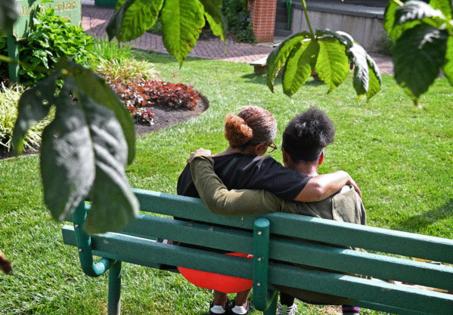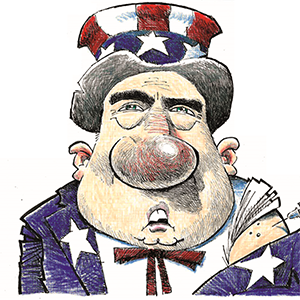Maryland homeless students feel the brunt of housing unaffordability
Published in News & Features
BALTIMORE — A mother and 11-year-old daughter fleeing domestic violence moved to a Baltimore-area safe house in March. They had been homeless for more than a year, after a series of lost jobs and lost places to stay.
“It kept happening, and as far as I could see, I couldn’t stop it,” said the 11-year-old, who enrolled in and attended three middle schools in the span of one year. “So, instead of fighting it, [I] just accept it and move on.”
She is one of thousands of students who have become homeless since 2019. In that time, Maryland has seen a 24% rise in homeless students during that time, due to ever-increasing rental and housing costs. At the same time, federal funds allocated to assist homeless students, like tutoring, after-school programs, transportation and school supplies, are being rolled back, further imperiling these children.
The National Association for the Education of Homeless Children and Youth is a Georgia-based nonprofit, nonpartisan membership organization that advocates for educational equity for homeless youth.
“Many people don’t understand that youth homelessness is even an issue in our country,” Executive Director Deirdre Nicholson said. “It creates the pipeline to adult homelessness.”
Higher housing costs, growing rates of homelessness among students
Under the federal McKinney-Vento Assistance Act, homelessness doesn’t simply mean living outdoors — it includes students who live in emergency shelters, cars or motels, as well as those who are “doubling-up:” staying with friends or relatives.
While there are about 1.3 million students identified under McKinney-Vento, that number only scratches the surface — there are an estimated 4.2 million youth experiencing homelessness nationwide, Nicholson said. Although the school systems have better tools to identify them, a majority aren’t provided services, she said.
Homeless students in Baltimore City accounted for 5,732 of the student body population for the 2023-2024 school year. Baltimore County came close behind with 2,791, followed by Montgomery County with 1,804, according to Maryland State Department of Education data.
And as inflation has increased, along with the cost of living, so, too, has the cost of housing.
In Maryland, the average rental price rose 20.5% between 2019 to 2024, according to an analysis by The Sun of the Apartment List rent estimates monthly report.
Since 2000, the increase in rents and home prices has risen faster than income in the country, according to a 2024 analysis by the U.S. Treasury.
Simultaneously, there’s a larger demand for housing than available supply due to increased construction costs, local land-use and zoning restrictions and changing demographics, the Treasury analysis found.
School supplies, laundry: services for homeless students
Students enrolled in McKinney-Vento services can remain in and/or enroll in their school of choice, while also providing transportation, academic support, and other necessary services.
The 11-year-old’s new school helped some, the mother said. It gave them $200 for clothes, as well as school supplies and a new gym uniform under the federal program, the mother said. The school’s guidance counselor also worked with her daughter. (The Baltimore Sun is not disclosing the names of the mother and daughter to protect their safety.)
Schools also connect families with outside resources and organizations to get them back on their feet.
Jennifer Cox founded Empower4life, a Baltimore-based nonprofit organization that provides education and health programs for homeless youth.
This school year, she helped launch a laundry service at one Baltimore County school after a student whose family currently lives in a motel asked to wash his and his siblings’ clothes at school. Now, a lot of families come in to use the laundry machines.
It might sound like a simple thing to go to a laundromat, but families might not even have the funds for it, she said.
Cox said she has observed an increase in the needs of homeless students and families for the services her foundation provides over the past few years.
“These kids are coming home from school and they’re coming to really, really loud, stressful, chaotic, sometimes toxic environments,” Cox said. “These kids are not playing sports. They’re not going to the Boys and Girls Club.”
Homelessness leads to worse academic performance
Homelessness has a drastic impact on young people’s academic progress and well-being, said Melissa Kull, a senior researcher focusing on youth housing instability and mental health at the nonpartisan, nonprofit social science research organization American Institute of Research.
The stressful environment of cycling in and out of stable housing affects cognitive and social development in children, too, Kull said.
Younger children are more likely to develop anxiety and depression, and score lower on early academic tests than students not experiencing housing instability, she said. While, older children are better able to weather changes, because they’re missing school, she said, they may not graduate on time, or at all.
While the data shows an increase in the number of Maryland students experiencing homelessness, the numbers don’t tell the whole story. Some people whose children would qualify for services under McKinney-Vento never report their lack of fixed housing, out of fear, confusion or something else.
Carla and her children became homeless nine months ago after experiencing domestic violence, which landed her and her children in a safe house. She switches among friends’ homes, and her children split time between wherever she’s staying at the time and their father’s home.
Carla didn’t tell the school they had become homeless since she signed a contract with the safe house not to disclose their location, she said. She said she didn’t know her children were eligible for services.
As a result, they didn’t receive any — and at the same time, her children suffered the emotional and academic impacts that homeless children often do.
Her youngest son is autistic and had more frequent outbursts and triggers while in the shelter. Her 12-year-old son’s grades dropped significantly at that time, from As to Cs, she said. But now that they are in more stable conditions, his grades have bounced back.
He couldn’t concentrate and was uncomfortable in their new environment, she said.
She has been unable to find a job that can accommodate her youngest son’s needs as well as pay enough to cover basic needs.
She hasn’t applied for housing assistance because spaces are “nonexistent,” she said. The complex that would allow her children to remain in their school is waitlisted — and the waitlist is closed.
Others have been luckier, finding support at school and even housing.
LovRico Johnson Jr. and his 8-year-old daughter arrived at a Baltimore County shelter, located behind an abandoned school, three weeks ago.
They became homeless four months ago after suffering domestic violence. She has changed schools twice and their experience with housing instability, moving between shelters and hotels, has taken its toll. Her grades dropped, she refused to do homework and occasionally acted out.
Johnson said he told his daughter’s last school that they were homeless, but that they did nothing more than tell him about some resources. Her new school gave her book bags, school supplies and helped them find a new home they’ll go to at the end of the month, Johnson said.
She is excited to start the third grade soon and is enjoying summer camp in the meantime, she said.
One day, she hopes to become an astronaut and go to the moon.
©2025 The Baltimore Sun. Visit at baltimoresun.com. Distributed by Tribune Content Agency, LLC.







Comments